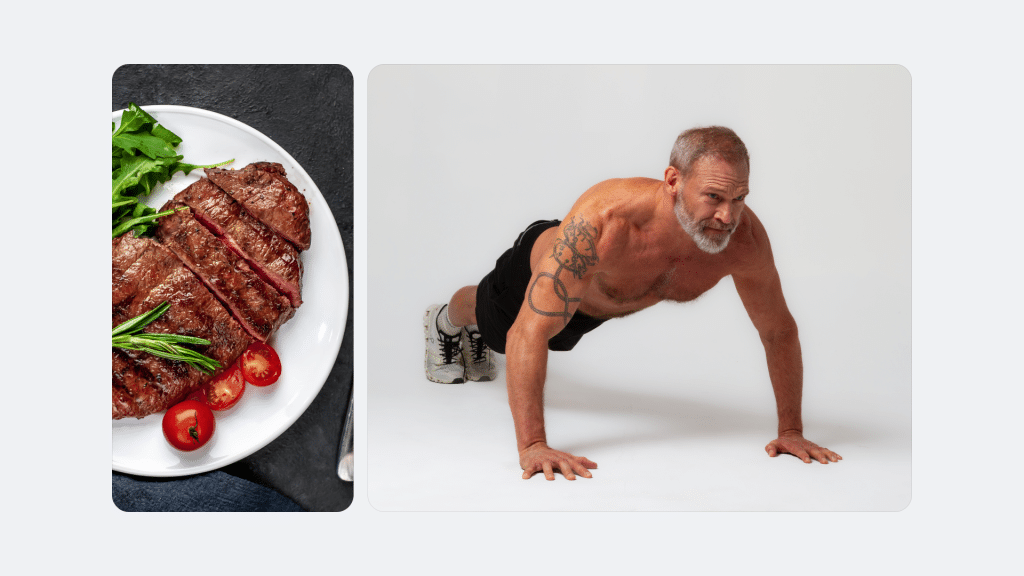There’s no question that a huge crowd has been raving about fasting for its health benefits for centuries. Earlier, people used to fast for spiritual reasons, but in modern times, the health rewards associated with fasting pull more people towards it.
You may choose to follow intermittent fasting for many reasons. Some want to lose weight, while others want to improve overall health.
Besides keeping track of your eating schedules, you should be mindful of what you eat during the non-fasting windows. The foods you eat during intermittent fasting can significantly impact whether you achieve your fitness goals.
Integrating the Paleo diet with intermittent fasting is one option some people choose.
Modern research on fasting has exploded, and hundreds of studies have suggested its potential positive impacts on human health. You want to support that by making healthy food choices. Right?
Combining Paleo and intermittent fasting is a step that some people hope could help in this regard. It prioritizes nutrient-dense foods but avoids some healthy and nutritious ones. If you’re not careful, your Paleo diet may be less balanced than is ideal.
This article entails the information you need to know about making intermittent fasting Paleo.
We’ve covered everything from the diet plan to tips and some intermittent fasting mistakes!
What Is An Intermittent Fasting Paleo Meal Plan?
An intermittent fasting paleo meal plan combines the 2 methods.
The Paleo Diet Food List Items
Paleo may have different meanings for different people. This diet, which is also known as the ancestral diet, emphasizes a variety of nutrition-dense foods, such as:
- Fruits, seeds, and nuts
- Starchy and non-starchy vegetables
- Animal products like shellfish, seafood, and eggs
This diet generally does not include dairy, grains, or legumes. Some believe early humans did not eat these foods in large quantities.
However, dairy, whole grains, and legumes are highly nutritious foods and should be in a healthy and balanced diet.
Intermittent Fasting
Intermittent fasting (IF) is a broad term for any eating pattern that limits food intake to specific times of the day. The approach varies based on individual goals, health, and lifestyle. Some people do it casually, like skipping a meal when traveling when healthy options aren’t available.
Others follow a structured routine, such as eating only within a 6-8 hour window each day (18:6 or 16:8 fasting).
Some may also fast for 24 hours once or twice a week or every other day, allowing a small amount of food intake (around 500 calories) on fasting days.
Intermittent fasting might support overall health by boosting autophagy, the body’s way of removing damaged cells and promoting the growth of new ones.
However, studies also suggest that extended fasting makes this cleansing process more likely to happen. In contrast, shorter fasting periods may primarily help with weight loss and metabolic improvements (1).
If you hope to lose weight, IF reduces your overall calorie intake.
If you fast but don’t necessarily eat fewer calories during your eating window than you otherwise would, you might not lose any weight. Food choices are essential, whether you are practicing IF or not.
When it comes to weight loss, progress is made by inches, not miles, so it’s much harder to track and a lot easier to give up. The BetterMe: Health Coaching app is your personal trainer, nutritionist, and support system all in one. Start using our app to stay on track and hold yourself accountable!
Can You Lose Weight Fast On A Paleo Diet?
Yes, a Paleo diet can help you to lose weight and maintain a healthy weight.
Paleo diet supporters believe it can help prevent modern health issues.
They point out that early humans didn’t face problems like obesity.
The Paleo diet can prevent obesity by cutting out most processed foods, sugar, dairy, and grains. Some versions allow certain foods like dairy and rice.
Unlike most diets, paleo doesn’t require counting calories.
Instead, it removes high-calorie foods common in today’s diets. Research suggests that eating more whole foods supports weight loss and better health.
The whole foods:
- Keep you full
- Have fewer calories
- Reduce ultra-processed food intake, which experts have linked to many diseases.
However, some of the foods the Paleo diet cuts out, like dairy, legumes, and whole grains, are healthy whole foods.
The following are some more reasons the Paleo diet might help you to lose weight:
- Paleo is low in carbs
Cutting carbs is one of the most popular ways to lose weight. Many studies suggest that a low-carb diet is as or more effective than other diets for losing weight, like a low-fat diet (2).
The diet eliminates familiar carb sources like rice, pasta, and bread. But you should know that completely removing carbs from your diet isn’t always healthy.
You might reduce the intake, but don’t cut it off altogether.
- Paleo is high in proteins
Protein is an essential macro for anyone who’s trying to lose weight. It can slightly boost your metabolism and help you feel full on fewer calories (3). The paleo diet emphasizes protein-rich foods such as lean meats, fish, and eggs. It provides about 25–35% of total calories from protein.
- Paleo removes processed foods
A growing trend of consuming processed and ultra-processed foods can be a significant reason behind obesity. The foods contain high amounts of calories and are hyperpalatable, which makes them easy to overeat.
The paleo diet avoids highly processed foods since they didn’t exist in the Paleolithic era.
Instead, Paleo promotes nutrient-dense and lower-calorie foods, such as:
- Vegetables
- Lean proteins
- Fresh fruits
- Healthy fats
Considering these factors, some researchers conducted studies on the Paleo diet.
They found some evidence that the Paleo diet may help with weight loss.
The weight loss benefits of Paleo are not surprising because diets that restrict certain foods or food groups tend to lead to reduced calorie intake.
For example, A study from The European Journal of Clinical Nutrition tracked 70 obese women over 60 who followed either a paleo or a more general diet for 2 years (4).
Both groups of women lost weight and improved some health markers, but the Paleo group saw more significant improvements, especially after the first 6 months of the study.
At the end of the 2 years, there was less difference between the 2 groups.
The researchers also noted that the Paleo group found getting their recommended amount of protein difficult.
A more recent systematic review and meta-analysis concluded that while the Paleo diet may be effective for weight loss and improving some health markers, we need more studies with larger populations and longer duration to understand the benefits and risks (5).
Read more: Your Ultimate Guide to the Low-Carb Paleo Diet
Which Diet Works Well With Intermittent Fasting?
Consult your doctor before you start intermittent fasting.
A healthcare professional can help you create a diet plan or recommend a registered dietitian to help you. Also, we can’t ignore that many factors influence dietary choices (6).
What works for one may or may not work for others.
Given that this guide is about Paleo and intermittent fasting, we’ll start by discussing how the Paleo diet is a potential plan to embed with the intermittent fasting routine.
Paleo is a restrictive diet likely to result in reduced calorie intake because it limits your food choices. Unfortunately, some of the food groups that paleo restricts are healthy, nutrient-dense foods, which most dieticians recommend for a healthy balanced diet.
Intermittent fasting can trigger autophagy, the body’s natural process of clearing out damaged cells while limiting the time you are allowed to eat, which can also reduce calorie intake.
The paleo intermittent fasting combination is relatively easy to follow since counting calories is unnecessary.
Just focus on eating whole, nutritious foods within a set timeframe.
Simple Paleo meal plans are naturally satisfying, which helps reduce unnecessary snacking, and IF creates a straightforward eating routine that fits different lifestyles.
Apart from the Paleo diet, dietitians recommend combining the Mediterranean diet with intermittent fasting.
The Mediterranean diet emphasizes fruits, vegetables, whole grains, legumes, seafood, nuts, and seeds.
Can You Combine Paleo And Intermittent Fasting?
You can follow a paleo diet intermittent fasting plan or combine any eating pattern that works for you. Intermittent fasting dictates when you can eat.
What you eat is for you to decide. Paleo is a restrictive diet that eliminates many unhealthy foods and some healthy, nutritious ones.
If you are an adult, have no medical conditions, are not pregnant or breastfeeding, and don’t take any medications you must take with food, then you may be able to try IF, Paleo, or both.
Talking to your healthcare provider first for individualized advice is still a good idea.
Jumping straight into intermittent fasting can be challenging, but easing in with a Paleo diet for a few weeks can make the transition smoother.
Here’s why:
- Helps Your Body Adapt: Paleo is typically low in carbs and so naturally lowers glucose levels, which can get your body more used to using fat for fuel, which you’ll be doing while fasting.
- Steady Energy: A balanced mix of protein, fats, and carbs at each meal keeps energy levels stable, so you don’t crash between meals (7).
- Fewer Blood Sugar Spikes: Cutting out processed foods with added sugars prevents the quick energy highs and lows that leave you tired and hungry.
So yes, you can combine the Paleo diet with intermittent fasting if you are careful about the dos and don’ts.
Some tips that could help you adopt the new eating patterns are:
- Take it easy! There’s no need to jump straight into an 8-hour eating window on day one. If you’re worried about hunger, take it slow.
Start by pushing your first meal back 30 minutes to an hour daily.
Do the same with your last meal. Once your body adjusts, you can stretch your fasting window even more. It’s all about easing in at your own pace.
- Hydrate yourself as much as possible. You can still have liquids during fasting, so don’t hesitate to take that water bottle with you wherever you go.
If hunger hits or you feel a dip in blood sugar, try an apple and coffee with MCT oil. It helps keep energy steady and cravings in check (8).
- Increase the intake of healthy fats and proteins during your eating window. Getting enough protein is key to preventing muscle loss, especially as you age (9). If you’re building muscle, you may need even more.
Healthy fats like olive oil and avocado help keep you full and energized.
Give yourself some margin to adjust and determine what your body needs.
Once you do that, you can DIY or get professional help to create a customized diet and fasting plan that inches you closer to your fitness goals.
Reasons why BetterMe is a safe bet: a wide range of calorie-blasting workouts, finger-licking recipes, 24/7 support, challenges that’ll keep you on your best game, and that just scratches the surface! Start using our app and watch the magic happen.
How Many Calories Per Day On An Intermittent Fasting Paleo Diet?
There’s no strict calorie limit on an intermittent fasting Paleo Diet. It’s more about when and what you eat rather than counting calories. Your daily intake depends on your goals, activity level, and metabolism.
Here are some general guidelines according to the calorie intake calculator:
- For Weight Loss: 1,500–1,800 calories per day (varies by sex, age, & activity level)
- For Maintenance: 1,800–2,500 calories per day
- For Muscle Gain: 2,500+ calories per day with higher protein intake
Paleo focuses on whole, nutrient-packed foods like lean meats, healthy fats, and veggies, so you’ll naturally eat fewer calories while staying satisfied.
The key is to listen to your body. Adjust your portions based on your hunger and energy levels.
Read more: Paleo Lunch Ideas For Weight Loss And Other Health Benefits
What Foods To Avoid On An Intermittent Fasting Paleo Diet?
An intermittent fasting paleo diet focuses on whole, minimally processed foods that early humans may have consumed daily. Paleo means cutting out anything that doesn’t align with a natural, ancestral way of eating.
- Processed foods: Chips, cookies, fast food, and anything with artificial additives
- Grains and legumes: Wheat, rice, oats, beans, lentils, and corn
- Dairy: Milk, cheese, yogurt, and butter (unless following a modified Paleo plan)
- Refined sugars: Candy, soda, baked goods, and sugary cereals
- Vegetable oils: Canola, soybean, and sunflower oils
You can be creative with your foods when combining Paleo with intermittent fasting.
For example, check out how to make high-protein Paleo meals flavorful so you can get the required protein to lose weight.
Yes, you can eat most foods during your eating window. However, it’s best to focus on nutrient-rich meals and avoid high-calorie, ultra-processed foods, especially if you want to lose weight. The 85:15 rule of the Paleo diet recommends that 85% of your meals consist of Paleo-friendly foods, while the remaining 15% can include non-Paleo options, making it more sustainable and flexible. After longer fasts, you might opt for gentle, easily digestible foods such as light soups, smoothies, or mild options like rice or toast while steering clear of high-fiber, fatty, sugary, or spicy foods. However, a 16-hour fast does not necessitate special care in breaking the fast – you can eat whatever you like. Yes, you can eat eggs while intermittent fasting, as they are a great source of protein and promote fullness. But, they should be consumed only during your eating window, not while fasting.Frequently Asked Questions
Is it ok to eat anything while intermittent fasting?
What is the 85:15 rule for paleo?
What is best to eat after 16-hour fast?
Can I eat eggs during intermittent fasting?
The Bottom Line
We wanted this guide to give readers insight into how they can blend intermittent fasting with a Paleo diet. Both strategies help decrease your calorie intake, potentially resulting in weight loss. Intermittent fasting determines when you eat and when you don’t.
The Paleo diet restricts certain food groups, some of which are healthy and nutritious.
Both IF and the Paleo diet may not be appropriate for everyone – it’s best to talk to your healthcare provider for individualized advice.
DISCLAIMER:
This article is intended for general informational purposes only and does not serve to address individual circumstances. It is not a substitute for professional advice or help and should not be relied on for making any kind of decision-making. Any action taken as a direct or indirect result of the information in this article is entirely at your own risk and is your sole responsibility.
BetterMe, its content staff, and its medical advisors accept no responsibility for inaccuracies, errors, misstatements, inconsistencies, or omissions and specifically disclaim any liability, loss or risk, personal, professional or otherwise, which may be incurred as a consequence, directly or indirectly, of the use and/or application of any content.
You should always seek the advice of your physician or other qualified health provider with any questions you may have regarding a medical condition or your specific situation. Never disregard professional medical advice or delay seeking it because of BetterMe content. If you suspect or think you may have a medical emergency, call your doctor.
SOURCES:
- Intermittent fasting and weight loss (2020, pmc.ncbi.nlm.nih.gov)
- Effects of Low-Carbohydrate Diets Versus Low-Fat Diets on Metabolic Risk Factors: A Meta-Analysis of Randomized Controlled Clinical Trials (2012, pmc.ncbi.nlm.nih.gov)
- A high-protein diet for reducing body fat: mechanisms and possible caveats (2014, nutritionandmetabolism.biomedcentral.com)
- Long-term effects of a Palaeolithic-type diet in obese postmenopausal women: a 2-year randomized trial (2014, pubmed.ncbi.nlm.nih.gov)
- Influence of Paleolithic diet on anthropometric markers in chronic diseases: systematic review and meta-analysis (2019, pmc.ncbi.nlm.nih.go)
- “We know what we should be eating, but we don’t always do that.” How and why people eat the way they do: a qualitative study with rural australians (2024, bmcpublichealth.biomedcentral.com)
- Understanding Food’s Impact on Glucose Levels (2021, joslin.org)
- Short-Term Influence of Caffeine and Medium-Chain Triglycerides on Ketogenesis: A Controlled Double-Blind Intervention Study (2021, pmc.ncbi.nlm.nih.gov)
- Protein Intake and Muscle Function in Older Adults (2015, pmc.ncbi.nlm.nih.gov)










